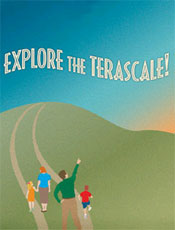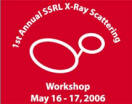

Wednesday - May 10, 2006
SLAC Today is
available online at:
http://today.slac.stanford.edu
In this issue:
New Report Gives Context for the Study of Very Small Things
People Today: Hills Are Easy
Correction to Article on Site-wide Safety Talks
Hands-on Workshop on X-ray Scattering
Electrical Safety Tip: Why Use PPE?
 |
 |
|
Wednesday - May 10, 2006 |

One of the many e-postcards
available at the Discovering the Quantum Universe website.
New Report Gives Context for
|
||||||||||||||||||||||||||
|
|
||||||||||||||||||||||||||
 Hills Are Easy
Berger races with the Webcor/Alto Velo Club, where several club members as well as her coach are National and World Champions. She counts herself lucky to be in inspiring company wherever she goes. Here at SLAC she rubs elbows with Nobel Prize winners, the world champions of physics. Berger says she enjoys the social aspects of bicycling. But there are also physical benefits to traveling in a pack. "When in a group, you can save up to 30% of energy as opposed to being by yourself," she says. Berger was pleasantly surprised to win the California/Nevada Climbing Championship last year. She says that as a native of Austria, hills seem to be in her blood; for her, cycling uphill is easier than on a flat surface. But she's quick to point out that downhill is fun too. Berger's fellow club members are currently organizing Beat the Clock and Help Beat Cancer, a bicycle training race series benefiting the Lance Armstrong Foundation. The series is organized by a good friend of Berger's, a cancer survivor herself. Anyone with a bicycle can participate, and donations are welcome. |
Correction to Article on Site-wide Safety TalksYesterday's article about the May 11th site-wide safety talks incorrectly identified who should receive suggestions of how to decrease injuries at SLAC. Managers should contact their directorate ES&H coordinator for information on where to submit these ideas. A compilation of these suggestions will then be provided to each program director for review by the ES&H Coordinating Council on May 16. Hands-on Workshop on X-ray Scattering
Sure, a textbook can tell you about Bragg's Law and the x-ray absorption energies for any element in the periodic table, but it can't tell you how to plan and carry out an x-ray scattering experiment at one of the 50 or so synchrotron radiation facilities in the world. To gain such practical knowledge, some 40 researchers, mostly graduate students and postdocs, have signed up for the Stanford Synchrotron Radiation Laboratory (SSRL) Workshop on Synchrotron X-ray Scattering Techniques in Materials and Environmental Sciences. Read more... Electrical Safety Tip: Why Use PPE?
Safety glasses, hard hats, long-sleeved shirts, long pants, steel or closed-toe shoes and safety harnesses are all examples of commonly used PPE. If an Area Hazard Analysis (AHA), Job Hazard Analysis and Mitigation (JHAM), work plan, breaker panel label or any form of procedure calls for the use of PPE, please use it. PPE only works if it is used. |
Events (see all | submit)
Access (see all)
Announcements
|
||||||||||||||||||||||||
| | ||||||||||||||||||||||||||
What's Cookin' at the Linear Cafe (see weekly menu)
|
||||||||||||||||||||||||||
|
|
||||||||||||||||||||||||||
 <%
Response.AddHeader "Last-modified", getArticleDate()
'Response.AddHeader "Last-modified","Mon, 01 Sep 1997 01:03:33 GMT"
'Monday, December 06, 2010
%>
<%
Response.AddHeader "Last-modified", getArticleDate()
'Response.AddHeader "Last-modified","Mon, 01 Sep 1997 01:03:33 GMT"
'Monday, December 06, 2010
%>View online at http://today.slac.stanford.edu/. |
||||||||||||||||||||||||||